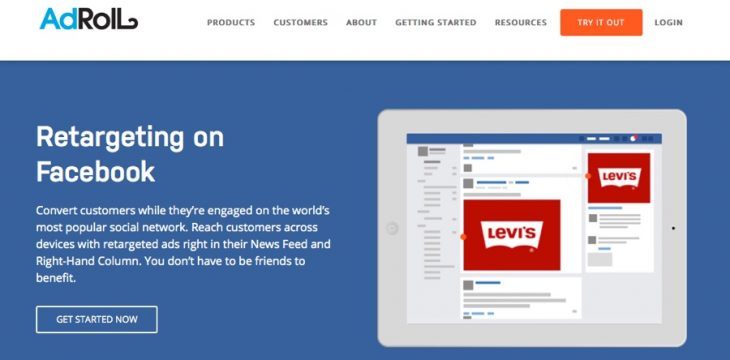Attracting new visitors to your website is never an easy process. Whether you’re creating and promoting content in search or running paid ad campaigns for qualified leads — it’s a lot of work.
It only makes sense that when a visitor lands on your website, you want to do everything in your power to convert them into a customer or client. But there is one problem:
Not every visitor who lands on your website is ready to buy. Some are in the process of performing research and others are just window shopping. Yet once they leave, there is a good chance they’ll never return (we posted an article about the buyer’s journey and lifecycle marketing not too long ago).
The challenge lies in making sure you’re able to stay top-of-mind once a visitor leaves your site. Left to their own devices, you’re facing an uphill battle. But thanks to retargeting (also known as remarketing), you stand a good chance of being able to draw a visitor back to your site once they’re closer to making a purchasing decision.
Introduction to Retargeting

Retargeting is the process of advertising specifically to visitors and customers who have expressed an interest in your product, service or brand. Here are the basic steps which can vary slightly depending upon your platform and chosen retargeting method:
- A visitor arrives on your site and begins browsing.
- Using JavaScript, a cookie is placed in a visitor’s browser.
- That visitor leaves your site and continues browsing the web.
- Eventually, they land on a website that serves ads to visitors.
- The cookie in your visitor’s browser will enable your ads to be displayed based on your preconfigured settings.
Whether you realize it or not, this process has probably happened to you. You visit an eCommerce site, browse a few products, maybe even load up your shopping cart. But then you get distracted and end up leaving. Over the next month or so, you notice the website or even the actual products you viewed popping up in various ads across the web.
Why You Should Use Retargeting
Retargeting benefits both consumers and businesses. There has been some discussion in past years where consumers have expressed concern that they are being followed and specifically targeted but attitudes have changed. In a 2013 study, eMarketer found that 30% of respondents felt positive and 59% felt neutral about retargeting ads.
From the perspective of a business, there are several advantages to retargeting that are worth considering:
- Retargeting allows you to remain “top of mind.” If a visitor to your site is still in the early phases of the buying process, they aren’t ready to make a decision. By presenting your ad at various intervals over the next 30+ days, they are more likely to remember you when it’s time to make a purchase.
- The average landing page across a broad spectrum of industries converts at a mere 2.35%. Retargeting has been shown to boost ad response by up to 400% — even a small increase in conversion rates can result in a huge jump in sales.
- Retargeting is a great way to promote a special offer to existing customers and increase brand awareness at the same time.
When to Use Retargeting

Effective retargeting requires a balancing act. You want to be in front of customers and prospects but you don’t want to appear to be following them around. If your ad shows up on every website they visit, interest quickly turns to annoyance.
For this reason, it’s important to balance placement, frequency and segmentation — targeting the people who are most likely to convert — the ease of which varies depending on your ad platform of choice.
Deciding when and where to implement retargeting can quickly become a complicated topic which is beyond the scope of this article. However, it’s still important to understand the general types of retargeting that you might consider implementing.
Site Retargeting
By far the most common form of retargeting is site retargeting. Site retargeting focuses on placing ads in front people who have visited your website. This is an easy retargeting method to use and abuse. Just because someone visits your website does not mean they are qualified or interested in seeing you ads across the web. They may not have liked your value proposition or they may have already decided to purchase from a competitor. This is very different than someone who filled and abandoned their shopping cart. Give careful consideration to where on your website you want to initiate tracking.
CRM Retargeting
CRM Retargeting allows you to target your mailing lists which, if well segmented, can prove to be very effective. Most platforms, such as AdRoll and ReTargeter provide an easy way to implement CRM retargeting. Simply upload your email list to their database and they’ll match up the individual online users with the respective email address and serve the appropriate ads.
Dynamic Retargeting
People’s needs and interests change and dynamic retargeting allows you to adjust your ads based on a visitors most recent interests. For example, if a customer browses an eCommerce store that sells cell phone cases, your advertiser could then present Facebook ads that featured the specific cell phone case that they showed interest in. Dynamic retargeting allows you to adapt your ad creatives to the needs of each individual user.
Facebook Retargeting
If your customers are online, there is a good chance you’ll find many of them on Facebook. Conveniently, Facebook provides a variety of ways to retarget your customers and visitors including email lists, website visitors and Facebook fans. Facebook’s ad platform can be accessed through Facebook itself as well a via third-party platforms like AdRoll.
Final Thoughts
Retargeting is a simple concept: Market to the people who have already expressed an interest in your product or service. Keep in mind we’ve only touched on the absolute basics in this post — there’s still a lot to learn.
Running an ad is easy. But the real value of retargeting lies in the ability to segment and target the right people at the right time and in the right place. A “spray and pray” approach might work, but it will be nowhere near as effective as a well-structured and coordinated remarketing campaign. Hopefully this introduction to retargeting basics has given you a foothold from which to further explore this powerful approach to recapturing your most valuable visitors.
If you have implemented remarketing for your business or have a favorite platform you’d like to share, please share in the comments below.
Image Credit: Pixabay
